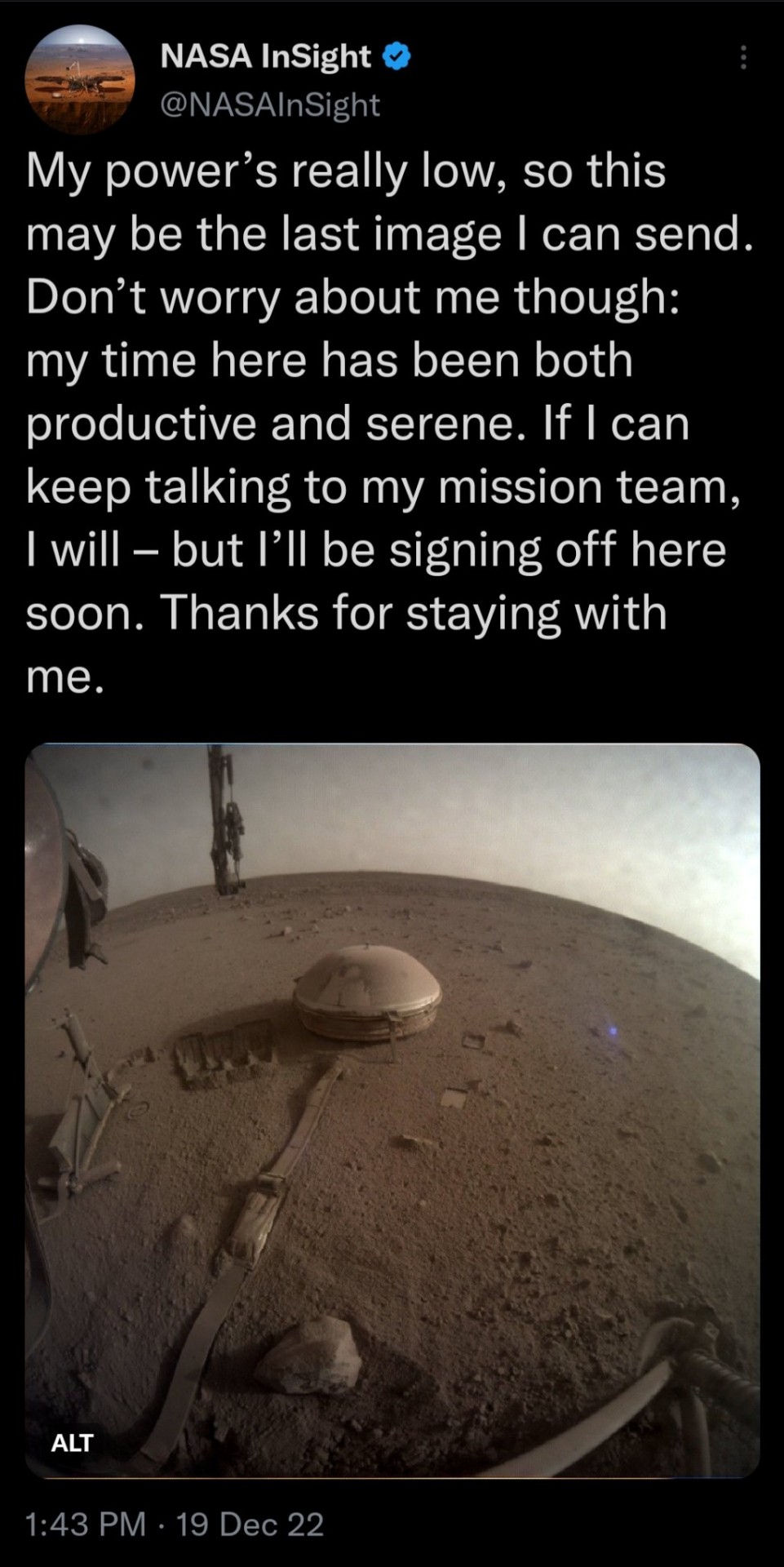#Mars InSight
Text
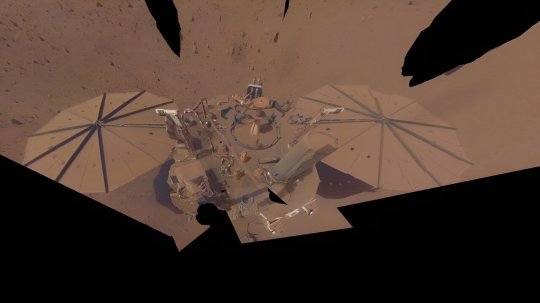
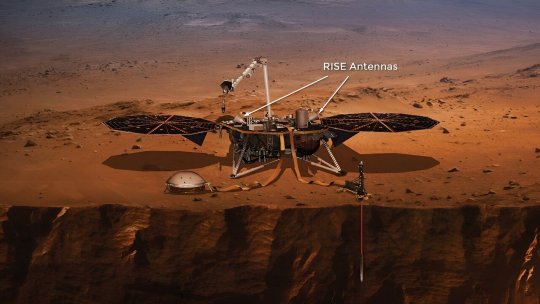
NASA InSight study finds Mars is spinning faster
Scientists have made the most precise measurements ever of Mars's rotation, for the first time detecting how the planet wobbles due to the "sloshing" of its molten metal core. The findings, detailed in a recent Nature paper, rely on data from NASA's InSight Mars lander, which operated for four years before running out of power during its extended mission in December 2022.
To track the planet's spin rate, the study's authors relied on one of InSight's instruments: a radio transponder and antennas collectively called the Rotation and Interior Structure Experiment, or RISE. They found the planet's rotation is accelerating by about 4 milliarcseconds per year—corresponding to a shortening of the length of the Martian day by a fraction of a millisecond per year.
It's a subtle acceleration, and scientists aren't entirely sure of the cause. But they have a few ideas, including ice accumulating on the polar caps or post-glacial rebound, where landmasses rise after being buried by ice. The shift in a planet's mass can cause it to accelerate a bit like an ice skater spinning with their arms stretched out, then pulling their arms in.
"It's really cool to be able to get this latest measurement—and so precisely," said InSight's principal investigator, Bruce Banerdt of NASA's Jet Propulsion Laboratory in Southern California. "I've been involved in efforts to get a geophysical station like InSight onto Mars for a long time, and results like this make all those decades of work worth it."
How RISE works
RISE is part of a long tradition of Mars landers using radio waves for science, including the twin Viking landers in the 1970s and the Pathfinder lander in the late '90s. But none of those missions had the advantage of InSight's advanced radio technology and upgrades to the antennas within NASA's Deep Space Network on Earth. Together, these enhancements provided data about five times more accurate than what was available for the Viking landers.
In the case of InSight, scientists would beam a radio signal to the lander using the Deep Space Network. RISE would then reflect the signal back. When scientists received the reflected signal, they would look for tiny changes in frequency caused by the Doppler shift (the same effect that causes an ambulance siren to change pitch as it gets closer and farther away). Measuring the shift enabled researchers to determine how fast the planet rotates.
"What we're looking for are variations that are just a few tens of centimeters over the course of a Martian year," said the paper's lead author and RISE's principal investigator, Sebastien Le Maistre at the Royal Observatory of Belgium. "It takes a very long time and a lot of data to accumulate before we can even see these variations."
The paper examined data from InSight's first 900 Martian days—enough time to look for such variations. Scientists had their work cut out for them to eliminate sources of noise: Water slows radio signals, so moisture in the Earth's atmosphere can distort the signal coming back from Mars. So can the solar wind, the electrons and protons flung into deep space from the sun.
"It's a historic experiment," said Le Maistre. "We have spent a lot of time and energy preparing for the experiment and anticipating these discoveries. But despite this, we were still surprised along the way—and it's not over, since RISE still has a lot to reveal about Mars."
Martian core measurements
RISE data was also used by the study authors to measure Mars's wobble—called its nutation—due to sloshing in its liquid core. The measurement allows scientists to determine the size of the core: Based on RISE data, the core has a radius of roughly 1,140 miles (1,835 kilometers).
The authors then compared that figure with two previous measurements of the core derived the from spacecraft's seismometer. Specifically, they looked at how seismic waves traveled through the planet's interior—whether they reflected off the core or passed through it unimpeded.
Taking all three measurements into account, they estimate the core's radius to be between 1,112 and 1,150 miles (1,790 and 1,850 kilometers). Mars as a whole has a radius of 2,106 miles (3,390 kilometers)—about half the size of Earth's.
Measuring Mars's wobble also provided details about the shape of the core.
"RISE's data indicate the core's shape cannot be explained by its rotation alone," said the paper's second author, Attilio Rivoldini of the Royal Observatory of Belgium. "That shape requires regions of slightly higher or lower density buried deep within the mantle."
While scientists will be mining InSight data for years to come, this study marks the final chapter for Banerdt's role as the mission's principal investigator. After 46 years with JPL, he retired on Aug. 1.
TOP IMAGE....NASA’s InSight lander captured this selfie on April 24, 2022, the 1,211th Martian day, or sol, of the mission. Dust on its solar panels caused the lander to lose power in December of that year, but data recorded by InSight’s instruments is still leading to new science. Credit: NASA/JPL-Caltech
LOWER IMAGE....This annotated artist’s concept of NASA’s InSight lander on Mars points out the antennas on the spacecraft’s deck. Along with a radio transponder in the lander, these antennas made up an instrument called the Rotation and Interior Structure Experiment, or RISE. Credit: NASA/JPL-Caltech
2 notes
·
View notes
Text
Death On Mars
‘My power’s really low’: Nasa’s Insight Mars lander prepares to sign off from the Red Planet
Robot says it might be sending its last message from Mars as dust chokes out its power supply
Image by yours truly

View On WordPress
0 notes
Text


1K notes
·
View notes
Text

Oh good. Because I needed more feelings tonight. 🫠
754 notes
·
View notes
Text
NASA's InSight mission to Mars helped scientists map out Mars' internal structure, including the size and composition of its core, and provided general hints about its tumultuous formation.
But findings from a new paper, titled "Geophysical evidence for an enriched molten silicate layer above Mars' core," published in the journal Nature could lead to reanalysis of that data. An international team of researchers discovered the presence of a molten silicate layer overlying Mars' metallic core—providing new insights into how Mars formed, evolved and became the barren planet it is today.
Published on October 25, 2023, the team's paper details the use of seismic data to locate and identify a thin layer of molten silicates (rock-forming minerals that make up the crust and mantle of Mars and Earth) lying between the Martian mantle and core. With the discovery of this molten layer, the researchers determined that Mars' core is both denser and smaller than previous estimates, a conclusion that better aligns with other geophysical data and analysis of Martian meteorites.
Continue Reading
72 notes
·
View notes
Text
Mars Be Down to Earth

Note: This post might not give you anything new if you're at an intermediate or advanced level of being on the astrology wildride :p
~~~~~~~~~~~~~~~~~~~~~~~~~~~~~~~~~~~~~~~~~~~~~~~~~~~~~~~~~~~~~~~
Earth Mars, on a good day: "I've nailed the art of deliberate moves. I go through my day with a solid purpose and a sprinkle of precision. I act, grounded in Earth's wisdom—that's the secret to my 'it' life"
Why?- So, we step into the cool world of Earth Mars. The Earth element is known for its steadfastness and its mastery of making what I refer to as 'money moves'. Because Earth is their turf; that's what they know like the back of their hand. It's their arena, and we're just hanging out in it, you know? I love admiring these creatures simply existing in their habitat. I learn a lot from them because I barely have any Earth in my birth chart at all, lol.
But yeah—Earth energy is all about being practical, grounded, and reliable, kind of like standing on solid ground, really. This Mars crew has a solid drive for the material world, finding fulfillment in real, concrete accomplishments. This is because they understand the tangible world like none of the other elements can. It's their superpower. They have the potential to realize their manifesting potential if they choose to align with it. They stand to be master manifestors and can teach it to the rest of us peasants as well.
There are a couple of ways, out of the infinite ways, it could manifest.
It could show up as a patient persistence, a (extremely sexy) dedication towards whatever it is you desire to have in your life. Plus, you probably dig channeling your energy into creative and sensory experiences, wink wink because you've got standards and love being comfortable. You could be interested in the idea of lasting success over instant gratification. in which case, good for you, Taurus Mars. You're already better than most of us on days when you're feeling yourself. If you can harness this power of yours, you stand to create successes that most people can ONLY dream of achieving. Your methodical approach to most things in life allows you to map out a plan to realize any dream—honestly, any god-loving dream out there. With your step-by-step strategic approach and action, you could go places, kid.
Now, if disciplined ambition, hard work, action rooted in wisdom, and endurance got thrown into a pot, the resulting concoction would be none other than a Capricorn Mars. Honestly, it's crazy how this sign tames the flames of Mars to bring out a more mature and sophisticated version of the fiery energies of Mars. Mars here isn't as prone to being impulsive, resulting in all its energetic impulses getting funneled into pure goal-oriented action, on a good day at least. It's the marriage of bold initiation and relentless hard work. What do you think the child of this is going to turn out to be? Legendary success? If you guessed that, you'd be correct. Efficiency might as well be this Mars' middle name here, and really its all about, in wise words, getting shit done. It's reliable, driven, capable, and acutely aware of what it takes to bring a desire about. It's honestly deliciously sexy to watch y'all do your thing. Keep going, you hot ass baddies. Show us what you're made of :]
Imagine Mars playing chess. If you did, you probably caught the essence of Virgo Mars. Smart, fast-thinking, doesn't miss the details and perfection-striving, Mars here is quite a force to be reckoned with. Mars goes for nothing but precision and will achieve it no matter how long. You guys will analyze the living crap out of any of your mistakes, which allows you to learn from them in a deeper way and make some pretty efficient changes to your overall plan to get where you need to go. Y'all are adaptable like that, which is quite impressive—it's great decision-making. Another thing about Mars here is that Virgo bestows a service-oriented mindset to the natives having this Mars, which, in turn, makes y'all humble-ass badasses, which is ridiculously amazing. OMG. Also, y'all enjoy taking care of your physical bodies and well-being, and it shows! Y'all love looking the part as you're kicking ass on your good days. This energy commands respect in a quiet way, which is low-key some big-dick energy. Love it!"
So that was my take on Mars in the Earth element. hope you liked it!

#astrology#spirituality#zodiac#capricorn#taurus#virgo#earth mars#astrology readings#astrology community#taurus mars#virgo mars#capricorn mars#zodiac insights#astrology observations
72 notes
·
View notes
Text
Edit: if I may add something, I'm not referring to their ground control when I say Spirit and Oppy are controlled by Macbooks. I mean the actual computer brains inside the rovers - as well as those for most of the 1990s-2000s Mars missions - were the same computers that were used in Macbooks. Enjoy!
#mars#space#spaceflight#nasa#history#mars rover#mars rovers#mars odyssey#insight#spirit#opportunity#oppy#ingenuity#perseverance#odyssey
73 notes
·
View notes
Text

It’s official… Controllers at NASA’s Jet Propulsion Laboratory (JPL) were unable to communicate with the the InSight Mars lander after two consecutive attempts earlier this month, which means the solar-powered batteries have run out of juice. Simply put, the lander is dead. After conducting years of unique and incredibly valuable science, NASA has officially retired InSight. This is its final image. Good night, sweet prince.
#nasa#space#engineering#science#technology#aerospace#spaceflight#space exploration#mars#martian#rover#lander#robot#robotics#nasa insight#insight
289 notes
·
View notes
Text

I'm not crying I just have a branch in my eye
186 notes
·
View notes
Text

#love#robots#mars rover#nasa#discovery#curiousity#spirit#explorer#swanjolras#stars#lonely#reach for the stars#insight#insightrover#space and astronomy#lost in space#space#space is beautiful limitless and terrifying#i hope there is something out there
165 notes
·
View notes
Text
“I’ll be signing off here, soon.” - InSight, Dec 20th 2022
“So, Human Andrea? Why we have landed on the [Planet of the War God]?”
The human before xem, entrenched in gear and insulated materials, face unseeable through the dark transparent mineral making up what they see through, spoke, “I was wondering if someone had, well, returned something.” Xir observed the lingering periwinkle across her nape and shoulders, tinting the usual peppy green she exuded.
“What is there to return? Humanity had never inhabited the [Planet of the War God], I believe. You achieved mass FTL travel before you learnt planet terraforming.”
“Hah,” the female laughed, “We may not have inhabited [Mars] but we did send… rovers. To see what it was like. We had planned, or discussed at the least, the inhabitability of it.”
They trudged through the barren dirt, Andrea staring determinately in one direction, likely observing a tracker of some sort on their HUD. Xir curiousity eventually got the better of xem.
“What, exactly, are you looking for, Human Andrea?”
The woman huffed, amused, “Well, I’m looking for the rovers, of course.”
“But why? Surely, by now, the rovers would’ve broken down?”
“Oh, probably.” Andrea’s body language, from what they could observe, was amused. Deeply so, even. The spike of yellow-green, followed by a melancholy purple deepened from the prior periwinkle cemented the fact. Deeply amused by xir confusion yet quite sad about their topic of conversation.
“I’m looking for InSight, mostly, but Sojourner, Spirit, Perseverance, or Curiousity are fine too. Maybe i’ll find Opportunity, but… Oh! Well. My scanners are showing that all of them are still here.”
The spike of wistfulness was unexpected, an almost positive tint to her words.
“You had said you were wondering if someone have returned something, why ‘returned’?”
“I was wondering if someone remembered them.” Here, it was sadness.
Xir blinked, or at least, that’s what xey believed how Human Andrea would describe xir Sight-Reset. Xey were blinded by the [spectrum of the sky] that flowed through her green.
“You are sad, that no one seems to have remembered these inconsequential rovers, yet you are… happy? That they are here for you to find?”
A spike of irritation, quickly washed away by resignment. “We humans pack bond to anything, Scylla, they’re not inconsequential to me.”
Xey do not believe that long-[powerless][dead][lost][depleted] rovers had impact on Human Andrea’s life, short as her existence (in terms of a human) had been. Still, xey trudged forward with the young adult, silent and grave as Human Andrea walked, a [ceremony of the dead] march, for comrades lost.
If xey had a phrase to describe it… ah, what was that saying in the [Lands of the Pariahs] of their home?
‘For as long as you exist, in memory or in bone, there is neither death nor [death in memory]’
Some notes about this for clarification and other stuff below :D
Andrea means Manly, and i thought it was fitting when i searched up the name halfway through writing.
Scylla, the alien, is a synaesthetic species wihout ‘eyes’ Xey are capable of seeing emotion (although everyone’s emotions have different colours. There is no universality to it. Someone’s anger could be a deep dark blue, for example, not a plain red.)
The ‘body language’ Scylla is referring to is, in fact, the synaesthesia that ripples with Andrea’s movements and emotions.
Scylla is indeed named after a deep sea greek monster, no i do not know why, but it is a nickname, not xir actual name (andrea gave it to xem after failing to pronounce xir actual name several times)
The phrases or words in square brackets are words that are being transliterated (if i’m using that word correctly) they are essentially words that i would’ve liked to have an english word for, or thought wouldn’t have the same terminology for an alien species.
Yes, i chose to make xem use ‘planet of the war god’ because i wanted to.
‘Spectrum of the sky’ is ‘rainbow’ if that wasn’t obvious.
the four phrases/words in a row were for long-dead except meant to be a more ‘general’ term for ‘loss of existence’ where ‘loss of existence’ wouldn’t have been gramatically or thematically correct.
‘Ceremony of the dead’ is indeed ‘funeral’ and, ‘death in memory’ is for a word i wish exists. It would make my poetry so much easier.
The ‘Land of the Pariahs’ mentioned is a barren desert on Scylla’s homeland. Nomads travel it, and are known for the hundreds of stories passed down, growing generation by generation, of pictures and pieces of lives once lived.
Scylla thinks the rovers had no impact on Andrea because they were a good few decades ago, actually. The newer ones were later retrieved, but Andrea had heard about these ones from grandparents etc. and fell in love with them.
This was written upon my knowledge of InSight’s loss of power, because of the dust build up on it’s solar panels. I pay my respects to the lander, and wish whatever tiny sliver of existence it had a peaceful future exploration of things that we do not know.
Finally, thank you for reading this! I hope you have a nice day/night and may we one day give our rovers and drones and landers their respectful resting places.
#randomartmaker rambles#randomartmaker writing#humans are space orcs#humans are space oddities#humans are space australians#humans are space fae#pack bonding#aliens#humans and aliens#nasa mars#mars#short story#small story#my writing#mars insight lander#wrote this at 10pm lolol#sorry to any injustices i do#i am tired
169 notes
·
View notes
Video
youtube
NASA's InSight hears its first meteoroid impacts on Mars NASA's InSight Mars lander has detected seismic waves from four space rocks that crashed on Mars in 2020 and 2021. Not only do these represent the first impacts detected by the spacecraft's seismometer since InSight touched down on Mars in 2018, but it also marks the first time seismic and acoustic waves from an impact have been detected on the red planet —a development providing scientists a new way to study Mars's crust, mantle and core. A new study published in Nature Geoscience—on which Brown University Assistant Professor (research) of Earth, Environmental and Planetary Sciences Ingrid Daubar is a co-author—details the impacts, which ranged between 53 and 180 miles from InSight's location, a region of Mars called Elysium Planitia. "It was super exciting," Daubar recalled of the impacts. "My favorite images are the ones of the craters themselves. After three years of waiting for an impact, those craters looked beautiful." Of the four confirmed meteoroids, which is the term used for space rocks before they hit the ground, the first one the team found made the most dramatic entrance: It entered Mars' atmosphere on Sept. 5, 2021, exploding into at least three shards that each left craters behind. When NASA's Mars Reconnaissance Orbiter flew over the estimated impact site to confirm the location, it used its black-and-white context camera to reveal three darkened spots on the surface. After locating these spots, the orbiter's team used the High-Resolution Imaging Science Experiment camera to get a color close-up of the craters. There is also audio of the impacts available. After combing through earlier data, three other impacts were confirmed as occurring on May 27, 2020; Feb. 18, 2021; and Aug. 31, 2021. "Having a really precise location for the source of the impacts calibrates all other data for the mission," Daubar said. "This validates the estimates we've made and will allow us to do this more precisely… It also tells us a lot about the impact process itself and the seismic results. We've never actually seen this before." Researchers have puzzled over why they haven't detected more meteoroid impacts on Mars. The red planet is next to the solar system's main asteroid belt, which provides an ample supply of space rocks to scar the planet's surface. Because Mars' atmosphere is just 1% as thick as Earth's, more meteoroids pass through it without disintegrating. Moreover, InSight's seismometer has detected more than 1,300 "marsquakes." Provided by France's space agency, the Centre National d'Études Spatiales, the instrument is so sensitive that it can detect seismic waves from thousands of miles away. But the Sept. 5, 2021, event marks the first time an impact was detected. InSight's team suspects that other impacts may have been obscured by noise from wind or seasonal changes in the atmosphere. Now that the distinctive seismic signature of an impact on Mars has been discovered, scientists expect to find more hiding within InSight's nearly four years of data. Planetary passion For Daubar—who in addition to her role at Brown is a research scientist with the NASA Jet Propulsion Laboratory leading the Impact Cratering Working Group on the InSight mission—she sees the data's potential for enabling further study of other planets, including Earth. "In a broader sense, the reason we study other planets is to understand our own planet better," she said. Daubar has been an assistant professor of planetary sciences at Brown for three years, but her cosmic curiosity developed much earlier. "I was lucky enough that my public high school in East Lyme, Connecticut, had a planetarium," Daubar said. "It sparked my interest in astronomy and space." In college, she majored in astronomy at Cornell University. She went on to earn a Ph.D. in planetary sciences at the University of Arizona and became a research scientist with JPL. "I love craters," Daubar said. "I think they're one of more exciting planetary processes we can study." Daubar is among several hundred scientists and engineers around the world contributing to the InSight mission, she said. "I'm a visual person and I've worked on cameras a lot," she said, "so to me, having the visual evidence of this physical phenomenon is really exciting. We actually have 'before and after' images. It's so cool to me that surface of this plant is changing right now. It's not some ancient geologic process." Science behind the strikes The data from the meteoroid impacts offer various clues that will help researchers better understand Mars. "We have tons of data, which is really exciting for scientists," Daubar said. "We've explored the planet a lot. There's a lot we know—and a lot we don't know." Most marsquakes are caused by subsurface rocks cracking from heat and pressure. Studying how the resulting seismic waves change as they move through different material provides scientists a way to study Mars's crust, mantle and core. The four impacts confirmed so far produced small quakes with a magnitude of no more than 2.0. That doesn't provide scientists with a glimpse deeper than the Martian crust, whereas seismic signals from larger quakes, like the magnitude 5 temblor that occurred in May 2022, can reveal details of the planet's mantle and core. "These particular impacts are really small and close—they didn't go through mantle and core," Daubar said. "But it allows us to use this knowledge for the whole catalog of events with a new understanding from these data points on location and source." Importantly, the impacts will be critical to refining Mars's timeline. "Impacts are the clocks of the solar system," said Raphael Garcia, of Institut Supérieur de l'Aéronautique et de l'Espace in Toulouse, France, who is the study's lead author. "We need to know the impact rate today to estimate the age of different surfaces." Scientists can approximate the age of a planet's surface by counting its impact craters. On Mars, the surface has had more time to accumulate impact craters of various sizes because the planet lacks the tectonic plate movement and active volcanism that constantly renews the surface, as they do on Earth. By calibrating statistical models based on how often they see impacts occurring now, scientists can estimate how many more impacts happened earlier in the solar system's history. "Seismology is one way we can tell what's inside a planet," Daubar explained. "The InSight mission is the first mission to actually study the interior of the planet." InSight's data, in combination with orbital images, can be used to rebuild a meteoroid's trajectory and how big its shock wave was. Every meteoroid creates a shock wave as it hits the atmosphere and an explosion as it hits the ground. These events send sound waves through the atmosphere. The bigger the explosion, the more this sound wave tilts the ground when it reaches InSight. The lander's seismometer is sensitive enough to measure how much the ground tilts from such an event and in what direction. "We're learning more about impact process itself," Garcia said. "We can match different sizes of craters to specific seismic and acoustic waves now."
5 notes
·
View notes
Text
pretty much everything we know about tori's childhood (which is quite a bit by enst standards), we know through other characters....... but what was it like for Him............ unreliably narrated: the people telling the story are complicatedly in love with him
13 notes
·
View notes
Text
NOOOO!!!!
NOT INSIGHT MARS ROVER TOO
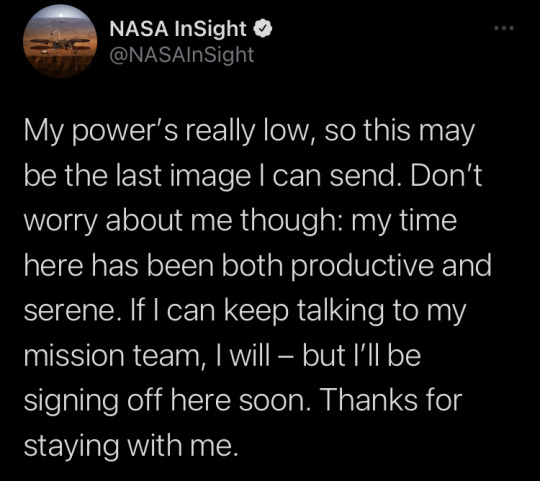
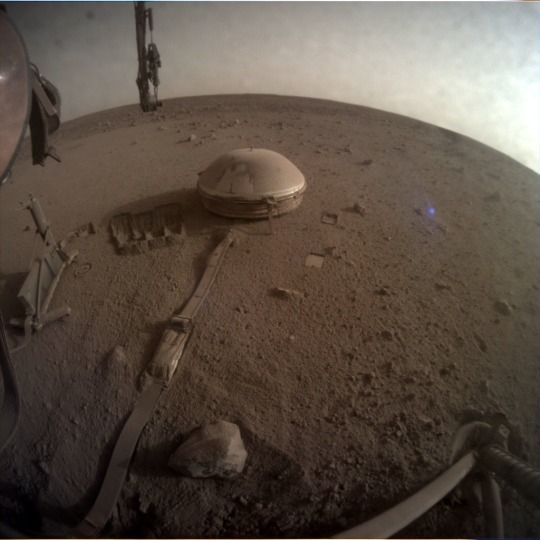
122 notes
·
View notes
Text
According to data from the now-retired InSight lander, Mars' rotation is accelerating each year by around 4 milliarcseconds. That's a very small amount – shortening the length of a Mars day by just a fraction of a millisecond every Martian year – but the reason for it is not immediately apparent.
However, the finding could lead us to a better understanding of Mars and its past evolution. The current forerunning hypotheses explaining the acceleration are long-term trends – such as accumulating material at the polar ice caps – and interior dynamics.
"It's really cool to be able to get this latest measurement – and so precisely," says planetary geophysicist Bruce Banerdt of NASA's Jet Propulsion Laboratory. "I've been involved in efforts to get a geophysical station like InSight onto Mars for a long time, and results like this make all those decades of work worth it."
Continue Reading
94 notes
·
View notes
